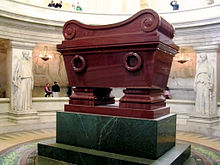In February 1821, his health began to fail rapidly, and on 3 May two British physicians who had recently arrived attended him and could only recommend palliatives.
He died two days later, after confession,
Extreme Unction and
Viaticum in the presence of Father Ange Vignali.
His last words were, "France, armée, tête d'armée, Joséphine."("France, army, head of the army, Joséphine.")
Napoleon's original death mask was created around 6 May, though it is not clear which doctor created it.
In his will, he had asked to be buried on the banks of the
Seine, but the British governor said he should be buried on St. Helena, in the
Valley of the Willows. Hudson Lowe insisted the inscription should read 'Napoleon Bonaparte';
Montholon and
Bertrand wanted the Imperial title 'Napoleon' as royalty were signed by their first names only. As a result the tomb was left nameless.
In 1840,
Louis Philippe I obtained permission from the British to return Napoleon's remains to France. The remains were transported aboard the frigate
Belle-Poule, which had been painted black for the occasion, and on 29 November she arrived in
Cherbourg. The remains were transferred to the steamship
Normandie, which transported them to
Le Havre, up the Seine to
Rouen and on to Paris. On 15 December, a
state funeral was held. The hearse proceeded from the Arc de Triomphe down the
Champs-Élysées, across the
Place de la Concorde to the
Esplanade des Invalides and then to the cupola in St Jérôme's Chapel, where it stayed until the tomb designed by
Louis Visconti was completed. In 1861, Napoleon's remains were entombed in a
porphyry sarcophagus in the crypt under the dome at Les Invalides.


0 comments:
Post a Comment